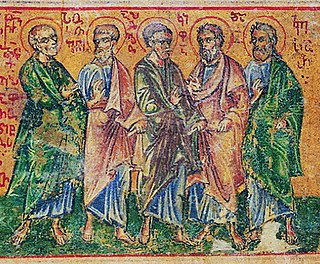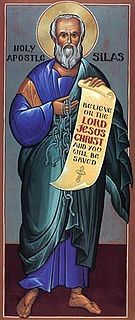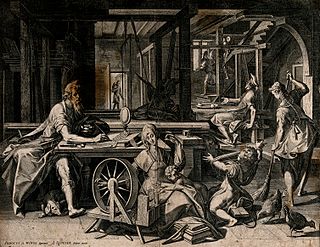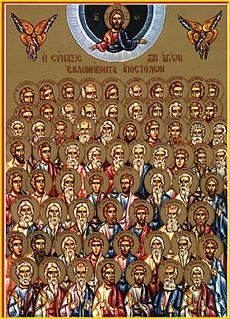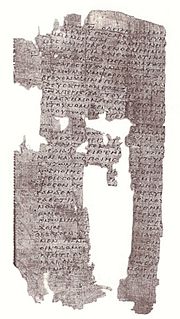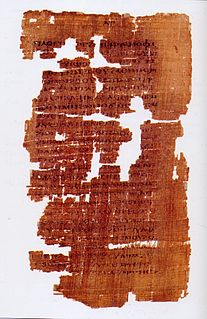The Epistle to Corinth was a letter written by the 'brethren' (Greek : οι αδελφοι) of the early Christian Church in Ephesus to the church in Corinth in Achaia, referred to in the Acts of the Apostles, commending the Corinthian church to welcome the preacher Apollos:

Greek is an independent branch of the Indo-European family of languages, native to Greece, Cyprus and other parts of the Eastern Mediterranean and the Black Sea. It has the longest documented history of any living Indo-European language, spanning more than 3000 years of written records. Its writing system has been the Greek alphabet for the major part of its history; other systems, such as Linear B and the Cypriot syllabary, were used previously. The alphabet arose from the Phoenician script and was in turn the basis of the Latin, Cyrillic, Armenian, Coptic, Gothic, and many other writing systems.

Ephesus was an ancient Greek city on the coast of Ionia, three kilometres southwest of present-day Selçuk in İzmir Province, Turkey. It was built in the 10th century BC on the site of the former Arzawan capital by Attic and Ionian Greek colonists. During the Classical Greek era it was one of the twelve cities of the Ionian League. The city flourished after it came under the control of the Roman Republic in 129 BC.

Corinth was a city-state (polis) on the Isthmus of Corinth, the narrow stretch of land that joins the Peloponnese to the mainland of Greece, roughly halfway between Athens and Sparta. The modern city of Corinth is located approximately 5 kilometres (3.1 mi) northeast of the ancient ruins. Since 1896, systematic archaeological investigations of the Corinth Excavations by the American School of Classical Studies at Athens have revealed large parts of the ancient city, and recent excavations conducted by the Greek Ministry of Culture have brought to light important new facets of antiquity.
- "And when [Apollos] desired to cross to Achaia, the brethren wrote, exhorting the disciples to receive him" (Acts 18:27). [1]
The letter is now lost.
English biblical translators differ in their interpretation of the 'encouraging' (Greek : προτρεψάμενοι) role of the letter, as it can be interpreted as encouraging Apollos (e.g. the ASV translation: "the brethren encouraged him, and wrote to the disciples ..."), or as encouraging the Corinthian church (e.g. the Modern English Version: "the brothers wrote to encourage the disciples to welcome him"). The Pulpit Commentary suggests it is "rather more consonant to the structure of the sentence and to the probability of the case that the exhortation was addressed to the Corinthian Church, and not to Apollos, who needed no such encouragement". [2]

The Revised Version, Standard American Edition of the Bible, more commonly known as the American Standard Version (ASV), is a Bible translation into English that was completed in 1901, with the publication of the revision of the Old Testament; the revised New Testament had been released in 1900. It was originally best known by its full name, but soon came to have other names, such as the American Revised Version, the American Standard Revision, the American Standard Revised Bible, and the American Standard Edition. By the time its copyright was renewed in 1929, it had come to be known by its present name, the American Standard Version. Because of its prominence in seminaries, it was in America sometimes simply called the "Standard Bible".

The Modern English Version (MEV) is an English translation of the Bible begun in 2005 and completed in 2014. The work was edited by James F. Linzey, and is an update of the King James Version (KJV), re-translated from the Masoretic Text and the Textus Receptus. The ecumenical Committee on Bible Translation is composed of 47 American and English scholars from the three major branches of Christendom: Orthodox, Protestant, and Roman Catholic.
The Pulpit Commentary is a homiletic commentary on the Bible created during the nineteenth century under the direction of Rev. Joseph S. Exell and Henry Donald Maurice Spence-Jones. It consists of 23 volumes with 22,000 pages and 95,000 entries, and was written over a 30-year period with 100 contributors.

